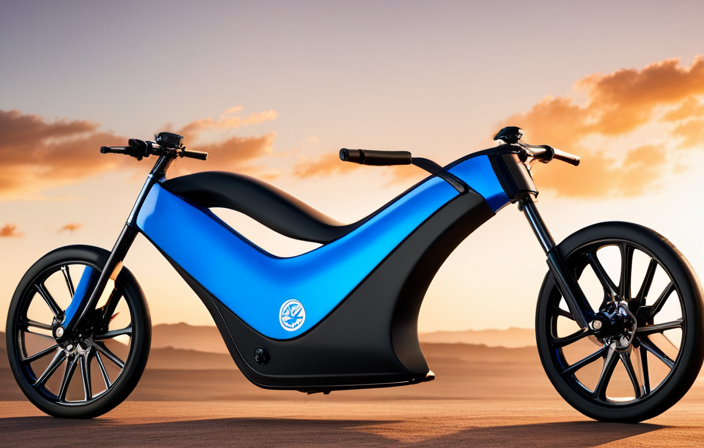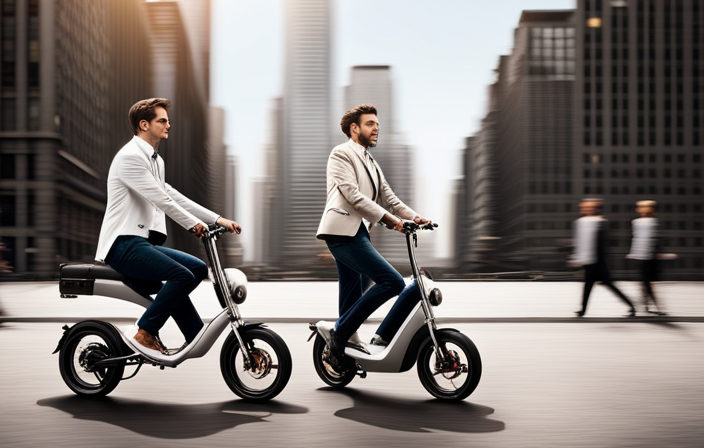When it comes to choosing an electric bike, I can’t help but picture myself cruising effortlessly along scenic trails, the wind in my hair and a smile on my face. But finding the perfect e-bike involves more than just daydreaming.
In this guide, I’ll share my expertise on how to select the ideal electric bike for your needs. From considering your riding style and commute distance to evaluating battery range and motor power, I’ll provide all the details you need to make an informed decision.
Let’s get started!
Key Takeaways
- Consider your riding style and choose an electric bike that suits your needs.
- Evaluate the battery range and motor power to ensure they meet your commuting requirements.
- Look at the frame size and weight of the electric bike for comfort and ease of use.
- Consider the suspension system and braking system for a smoother and safer ride.
Determine Your Riding Style
To determine your riding style, you’ll need to consider factors such as terrain, distance, and desired level of assistance. Your riding preferences play a crucial role in choosing the right electric bike for you.
When it comes to terrain considerations, think about the types of surfaces you’ll be riding on. Are you planning to ride mostly on paved roads, or do you want to tackle off-road trails as well? If you’ll be riding on uneven terrains or hilly areas, you’ll need an electric bike with a powerful motor and good suspension to handle those challenges. On the other hand, if you’ll be sticking to smooth roads, a bike with a less powerful motor and lighter frame might be more suitable.
Additionally, think about your desired level of assistance. Some riders prefer a bike with multiple levels of assistance, allowing them to control the amount of power they receive. Others may prefer a bike with a continuous assist feature, providing a consistent level of assistance throughout the ride.
By considering your riding preferences and terrain considerations, you can find an electric bike that meets your needs and enhances your riding experience.
When it comes to choosing an electric bike, it’s also important to consider your commute distance.
Consider Your Commute Distance
When considering your commute distance, it’s important to take into account how far you’ll be traveling. Evaluating battery life and comparing motor power are two crucial factors to consider when choosing an electric bike that will meet your commuting needs.
To help you visualize the differences, let’s compare three electric bikes in a table:
| Electric Bike | Battery Life | Motor Power |
|---|---|---|
| Bike A | 40 miles | 250W |
| Bike B | 60 miles | 350W |
| Bike C | 80 miles | 500W |
As you can see, Bike A has a shorter battery life and a lower motor power compared to Bike B and Bike C. If you have a short commute distance, Bike A might be sufficient. However, if your commute is longer, you might want to consider Bike B or Bike C for their longer battery life.
Evaluating battery life is important because it determines how far you can travel on a single charge. Comparing motor power is also crucial as it determines the bike’s ability to handle steep hills or rough terrains.
Now that we have considered the distance we’ll be traveling, let’s move on to evaluating the battery range in the next section.
Evaluate the Battery Range
Evaluate the battery range based on how far you need to travel on your commute. When choosing an electric bike, it’s crucial to consider the battery life as it determines how long you can ride without recharging.
To evaluate battery life, start by comparing battery technologies. Lithium-ion batteries are the most common and offer a good balance between weight, cost, and performance. They provide a decent range and are lightweight, making them ideal for daily commuting. However, if you have a longer commute or plan to use your electric bike for longer rides, you may want to consider bikes with more advanced battery technologies like lithium polymer or solid-state batteries. These batteries offer extended ranges and are more efficient, but they can be more expensive.
Transitioning into the next section about assessing the motor power, it’s important to note that the motor power directly impacts the battery life. By choosing an electric bike with an appropriate motor power for your needs, you can optimize the battery range and enjoy a smooth and efficient ride.
Assess the Motor Power
Assessing the motor power is crucial because it directly affects how far you can ride on a single charge. When choosing an electric bike, it’s important to consider the motor power to ensure that it meets your needs and preferences. The motor power is measured in watts and determines the strength and efficiency of the bike. Higher motor power generally means more speed and acceleration, but it also consumes more battery power. On the other hand, lower motor power may result in slower speeds, but it can conserve battery life.
To help you make an informed decision, here are some factors to consider when assessing the motor power of an electric bike:
| Factor | Importance |
|---|---|
| Terrain | If you plan to ride on steep hills or rough terrains, a higher motor power is recommended for better performance and easier climbing. |
| Weight | If you are a heavier rider or plan to carry heavy loads, a higher motor power will provide better assistance and prevent strain on the motor. |
| Speed | If you prefer faster speeds, a higher motor power will allow you to reach higher velocities more easily. |
Choosing the right motor power for your electric bike is essential for a satisfactory riding experience. It’s crucial to consider your specific needs and preferences, as well as the factors mentioned above. Assessing the motor power will help you find an electric bike that can deliver the performance and range you desire.
With motor power considered, the next step is to choose the right frame size for your electric bike.
Choose the Right Frame Size
Now that motor power has been considered, the next step is to select the appropriate frame size for your e-bike. Choosing the right frame size is crucial when it comes to the overall comfort, control, and performance of your electric bike. The importance of proper fit cannot be overstated.
Riding an e-bike that is too small or too large for your body can lead to discomfort, inefficient pedaling, and even injury.
To determine the right frame size, you should consider your height, leg inseam, and riding style. Most e-bike manufacturers provide sizing charts that correlate frame sizes with rider heights. These charts can serve as a starting point, but it’s important to remember that individual body proportions and comfort preferences may vary. It’s always a good idea to test ride different frame sizes to find the one that feels the most comfortable and natural for you.
A frame size that is too small may result in cramped leg and arm positioning, leading to a less efficient pedaling motion. On the other hand, a frame size that is too large can make it difficult to reach the handlebars and properly control the bike. Finding the right balance between comfort and control is key.
Considering the weight of the electric bike is also important in achieving optimal performance and ease of use.
Consider the Weight of the Electric Bike
When choosing an e-bike, it’s important to consider the weight of the bike as it can significantly impact the performance and ease of use for you. The weight distribution of an electric bike plays a crucial role in its maneuverability. To better understand the implications, let’s take a look at the following table:
| Weight Distribution | Impact on Maneuverability |
|---|---|
| Centered | Balanced, easier to control |
| Front-Heavy | Difficulty in steering, slower turns |
| Rear-Heavy | Unstable, risk of wheelies |
As you can see, the weight distribution directly affects how the e-bike handles. Opting for a bike with a centered weight distribution will provide a balanced ride, making it easier to control. On the other hand, a front-heavy bike may pose challenges in steering and make turns slower. Meanwhile, a rear-heavy bike can be unstable and even result in the front wheel lifting off the ground, which is not ideal.
Considering the weight of the e-bike is essential to ensure a smooth and enjoyable riding experience. It’s worth noting that the weight of the bike itself can also impact its maneuverability. Heavier bikes may require more effort to accelerate and maneuver, particularly in tight spaces or uphill. Therefore, finding a balance between weight and maneuverability is crucial when selecting an electric bike.
With the understanding of weight distribution and its impact on maneuverability, let’s now move on to evaluating the suspension system—another vital aspect to consider when choosing an e-bike.
Evaluate the Suspension System
Take a moment to consider the suspension system of the e-bike you’re considering, as it can greatly impact your riding comfort and overall performance. The suspension system plays a crucial role in absorbing shocks and bumps, ensuring a smooth and enjoyable ride. When evaluating the suspension system, there are a few key factors to consider:
-
Suspension Types: There are various suspension types available, including front suspension, rear suspension, and full suspension. Front suspension, also known as a hardtail, provides suspension only in the front fork, while rear suspension adds suspension to the rear wheel. Full suspension, on the other hand, incorporates both front and rear suspension, providing the highest level of comfort and control.
-
Weight Distribution: It’s important to consider the weight distribution on the bike. A well-balanced bike with even weight distribution will offer better stability and handling. Look for a suspension system that can handle the weight of both the rider and the battery without compromising performance.
-
Travel: The travel of a suspension system refers to the distance the suspension can compress and extend. More travel typically means better shock absorption and a smoother ride, especially on rough terrains. Consider your riding style and the type of terrain you’ll be riding on to determine the appropriate amount of travel for your e-bike.
-
Adjustability: A suspension system that offers adjustability allows you to fine-tune the settings to match your riding preferences and the specific terrain you’re tackling. Look for options such as adjustable rebound, compression, and preload settings to personalize your riding experience.
-
Quality and Durability: Finally, evaluate the quality and durability of the suspension system. Look for reputable brands and models known for their reliability and longevity. A well-designed and well-constructed suspension system will ensure optimal performance and longevity.
Considering these factors will help you make an informed decision when evaluating the suspension system of an e-bike. Once you’ve evaluated the suspension system, it’s important to look for quality brakes and gears to further enhance your riding experience.
Look for Quality Brakes and Gears
To ensure a safe and smooth ride, it’s important to look for quality brakes and gears when evaluating an e-bike’s components.
Brake performance is a crucial aspect to consider when choosing an electric bike. You want a bike that can effectively stop when needed, especially when traveling at higher speeds. Hydraulic disc brakes are the best option, as they offer superior stopping power and are more reliable in wet conditions. Mechanical disc brakes are also a good choice, providing solid stopping power at a more affordable price point. On the other hand, rim brakes should be avoided as they are less effective and can wear out quickly.
When it comes to gears, functionality is key. Electric bikes often have multiple gears to assist with pedaling and provide a smoother ride. Look for bikes with a wide range of gear options, allowing you to easily tackle different terrains and inclines. Additionally, consider the shifting mechanism. A bike with a responsive and smooth gear shifting system will enhance your overall riding experience.
Now that you understand the importance of quality brakes and gears, let’s move on to the next consideration: the type of electric bike.
Consider the Type of Electric Bike (City, Mountain, Folding, etc.)
Now that you have evaluated the quality of brakes and gears, it’s time to consider what type of electric bike suits your needs. This will depend on whether it’s for city commuting, mountain biking, or a folding option for easy storage. Choosing the right type of electric bike is crucial because it will determine your overall riding experience. Here are some factors to consider:
-
Riding in Different Terrains: Think about the kind of terrain you will be riding on. If you plan to conquer rugged mountain trails, a mountain electric bike with sturdy tires and suspension will be your best bet. For city commuting, a hybrid electric bike with a smooth ride and efficient handling is ideal.
-
Battery Charging Time: Another important factor to consider is the battery charging time. Different electric bikes have varying charging times, so it’s essential to find one that fits your lifestyle. If you have a long commute or plan to ride for extended periods, opting for a bike with a shorter charging time will be advantageous.
Considering these factors will help you narrow down your options and choose the perfect electric bike for your needs. Now, let’s move on to the next section and delve into the importance of checking the warranty and after-sales service.
Check the Warranty and After-Sales Service
Considering the warranty and after-sales service is crucial when making a decision about which electric bike to purchase. After all, you want to ensure that you not only have a quality product, but also the support and coverage in case something goes wrong. When evaluating different electric bike options, it’s important to look at the warranty coverage and the level of after-sales support provided by the manufacturer or retailer.
To help you understand the importance of warranty and after-sales service, here is a comparison table of three popular electric bike brands:
| Brand | Warranty Coverage | After Sales Support |
|---|---|---|
| A | 1 year | Phone, Email |
| B | 2 years | Phone, Email, Chat |
| C | 5 years | Phone, Email, Chat, In-person |
As you can see, the length of the warranty coverage varies between brands, with Brand C offering the longest coverage. Additionally, the level of after-sales support also differs, with Brand C providing the most comprehensive support options, including in-person assistance.
Considering these factors will give you a better understanding of the level of support you can expect after purchasing your electric bike. Now that you have an idea of the warranty and after-sales service, the next step is to test ride different models to ensure they meet your specific needs and preferences.
Test Ride Different Models
Before making a decision, it’s important to test ride various models to determine which one suits your needs and preferences. The test ride experience is crucial in evaluating the performance and comfort of an electric bike. When comparing different models, there are a few key factors to consider.
Firstly, pay attention to the bike’s power and motor performance. During the test ride, observe how quickly the bike accelerates and how smoothly it transitions between different levels of assistance. A powerful motor will provide a more enjoyable and effortless riding experience.
Next, focus on the bike’s handling and stability. Take the bike for a spin on various terrains, such as uphill climbs and bumpy roads. Notice how easy it is to maneuver and whether it feels stable and secure. A well-balanced bike will be easier to ride and control.
Additionally, consider the bike’s battery life and range. Take note of how far you can travel on a single charge and whether the battery meets your needs. It’s also important to assess how long it takes to recharge the battery fully.
Read Reviews and Compare Brands
Once you’ve narrowed down your options, it’s time to check out reviews and compare different brands. When it comes to choosing an electric bike, maintenance and service are of utmost importance. Regular maintenance ensures that your bike runs smoothly and extends its lifespan. It’s crucial to choose a brand that offers reliable service and has a good reputation for customer support. This is where customer reviews play a significant role in brand comparison.
To help you make an informed decision, here’s a table comparing three popular electric bike brands based on customer reviews, maintenance, and service:
| Brand | Customer Reviews | Maintenance and Service |
|---|---|---|
| Brand A | 4.5/5 | Excellent |
| Brand B | 4.2/5 | Good |
| Brand C | 4.8/5 | Outstanding |
As you can see, Brand C has the highest customer review rating and offers outstanding maintenance and service. However, it’s essential to read individual reviews to understand specific experiences and potential issues.
Now that you have an idea of which brands excel in maintenance and service, it’s time to set a budget for your electric bike without compromising quality or features.
Set a Budget
To determine your budget for an electric bike, you’ll need to evaluate your financial situation and prioritize what features are most important to you. Setting a budget is essential because it helps you narrow down your options and ensures that you don’t overspend.
Start by considering your budget constraints and how much you are willing to invest in an electric bike. Take into account any financial considerations such as monthly expenses, savings goals, and other financial obligations.
When setting a budget for an electric bike, it’s important to strike a balance between affordability and quality. While it may be tempting to go for the cheapest option available, keep in mind that a higher-quality electric bike will likely offer better performance, durability, and overall value in the long run. Consider the cost of maintenance and repairs, as well as any warranties or guarantees offered by the manufacturer.
Additionally, think about the specific features that are important to you. Are you looking for a powerful motor, a long-lasting battery, or a lightweight frame? Consider what you value most in an electric bike and prioritize those features when setting your budget.
As you evaluate your financial situation and prioritize the features that matter most to you, keep in mind that it’s also important to consider additional features such as lights, fenders, a rack, and more. These accessories can enhance your riding experience and provide added convenience and safety.
Now that you have a budget in mind, let’s explore the various additional features you may want to consider for your electric bike.
Consider Additional Features (Lights, Fenders, Rack, etc.)
When considering additional features for your electric bike, don’t forget to think about accessories like lights, fenders, and a rack. These accessories can greatly enhance your riding experience and provide added convenience.
When it comes to lights, you have the option of choosing between lights and reflectors. Lights are a popular choice as they provide better visibility, especially when riding at night or in low light conditions. They also help you be seen by other road users, increasing your safety on the road. Reflectors, on the other hand, are a more affordable option but may not provide the same level of visibility.
Moving on to fenders vs. mudguards, which is better? Well, it depends on your specific needs and preferences. Fenders are designed to keep water and dirt from splashing up onto you and your bike, making them ideal for wet or muddy conditions. They are usually made of lightweight plastic and are easy to install. On the other hand, mudguards are typically made of metal and provide more coverage, protecting your bike from mud and debris. They may be a bit heavier and more cumbersome to install, but they offer superior protection.
When choosing additional features for your electric bike, it’s important to consider your specific needs and preferences. Take into account the pros and cons of each option and assess which accessories will enhance your riding experience the most. Once you have made your decision, it’s time to purchase from a reputable retailer who can provide you with quality products and reliable customer service.
Purchase from a Reputable Retailer
After considering additional features for your electric bike, it’s important to purchase from a reputable retailer. The reliability of electric bikes can vary depending on where you buy them, so choosing a trustworthy retailer is crucial.
I recently had a positive customer support experience when purchasing my own electric bike, and I believe it’s worth sharing.
When I was searching for an electric bike, I came across several online retailers offering tempting deals. However, I decided to go with a well-known local bike shop that specialized in electric bikes. This decision proved to be a wise one. The retailer provided me with expert advice and guidance, helping me select the perfect electric bike for my needs.
Moreover, their after-sales customer support was exceptional. Whenever I encountered any issues or had questions, their team was readily available to address my concerns. They even offered a warranty on the bike, providing me with peace of mind knowing that I had reliable support if anything went wrong.
Purchasing from a reputable retailer not only ensures the reliability of your electric bike but also guarantees a positive customer support experience. So, take the time to research and choose a retailer that is known for their quality products and excellent customer service. Trust me, it will make a world of difference in your electric bike journey.
Frequently Asked Questions
How long does it take to fully charge the electric bike’s battery?
It typically takes around 4-6 hours to fully charge the battery of an electric bike, depending on the battery capacity. It’s important to choose a bike with a battery that suits your needs and has a charging time that fits your lifestyle.
Can the motor power be adjusted to different levels?
Yes, the motor power of an electric bike can be adjusted to different levels. However, it’s important to note that increasing the motor power customization may have an impact on the battery life.
What is the average lifespan of the battery?
The average lifespan of an electric bike battery can vary depending on several factors. However, on average, you can expect the battery to last around 3-5 years before experiencing significant degradation. Factors like temperature, usage, and charging habits can affect its lifespan.
Are there any additional costs involved in owning an electric bike?
Yes, there are additional costs involved in owning an electric bike. Apart from the initial purchase, electric bike maintenance such as battery replacement and regular tune-ups can add up. However, when comparing with the cost of owning a car, electric bikes are still more affordable.
How often does the electric bike need to be serviced or maintained?
I’ve had my electric bike for a year now and it’s been a breeze to maintain. With regular check-ups every 6 months, I’ve had no major issues. Electric bike maintenance is simple and the servicing frequency is quite low.
Conclusion
After carefully considering my riding style, commute distance, battery range, motor power, frame size, and additional features, I have finally made a decision on which electric bike to purchase.
With the help of reading reviews and comparing brands, I was able to find the perfect fit for my needs.
It’s important to remember that when choosing an electric bike, it’s not just about the price, but also the quality and reliability. Therefore, I highly recommend purchasing from a reputable retailer to ensure a smooth and satisfying experience.
As they say, "don’t judge a book by its cover," and the same goes for electric bikes.









